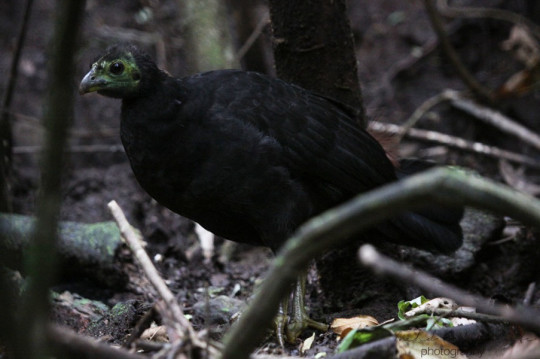#aepypodius arfakianus
Explore tagged Tumblr posts
Photo

A new variant has been added!
Wattled Brushturkey (Aepypodius arfakianus) © Mehd Halaouate
It hatches from bare, black, blue, difficult, dull, facial, female, large, male, maroon, other, pale, quiet, red, sharp, shy, and similar eggs.
squawkoverflow - the ultimate bird collecting game 🥚 hatch ❤️ collect 🤝 connect
0 notes
Text




224) Aepypodius arfakianus; Nogal koralikowy, wattled brushturkey (indyk szczotkowany) - gatunek ptaka z rodziny Megapodiidae. Występuje w Nowej Gwinei. Jego naturalne siedliska to subtropikalne lub tropikalne wilgotne lasy nizinne i subtropikalne lub tropikalne wilgotne lasy górskie.
Jest stosunkowo duży jak na megapody, z pewnym zauważalnym dymorfizmem płciowym. Dorosłe osobniki mają średnio 46 cm długości i ważą od 1,2 do 1,6 kg. Samice mają matową, szarą, nagą skórę twarzy, podczas gdy samce są bladoniebieskie. Ponadto czerwone dzwonki na głowie i klatce piersiowej są powiększone u samców, podczas gdy u samic są zmniejszone. Ogólnie rzecz biorąc, są podobne do innych indyków brushturkey, ale wattled brushturkey ma pionowo spłaszczony ogon z bordowym kuprem i ciemniejszymi nogami.
Te ptaki mają niezwykle szeroki zasięg występowania, co czyni je odpornymi na wpływ człowieka, z zasięgiem lęgowym wynoszącym około 685 000 km2. Są to bardzo płochliwe ptaki i trudno je zlokalizować. Te wszystkożerne ptaki często żerują na parterze, skrobiąc liście, aby odsłonić opadłe owoce, nasiona i bezkręgowce.
0 notes
Text
Aepypodius arfakianus, A. bruijinii

Wattled Brush Turkey, A. arfakianus, by Arjan Haverkamp, CC BY 2.0
PLEASE SUPPORT US ON PATREON. EACH and EVERY DONATION helps to keep this blog running! Any amount, even ONE DOLLAR is APPRECIATED! IF YOU ENJOY THIS CONTENT, please CONSIDER DONATING!
Name: Aepypodius arfakianus, A. bruijinii
Status: Extant
First Described: 1880
Described By: Oustalet
Classification: Dinosauria, Saurischia, Eusaurischia, Theropoda, Neotheropoda, Averostra, Tetanurae, Orionides, Avetheropoda, Coelurosauria, Tyrannoraptora, Maniraptoriformes, Maniraptora, Pennaraptora, Paraves, Eumaniraptora, Averaptora, Avialae, Euavialae, Avebrevicauda, Pygostylia, Ornithothoraces, Euornithes, Ornithuromorpha, Ornithurae, Neornithes, Neognathae, Galloanserae, Pangalliformes, Galliformes, Megapodiidae
Aepypodius is a genus of Megapodes, containing two species - the Wattled Brushturkey, A. arfakianus, and the Waigeo Brushturkey, A. bruijinii. There is no fossil evidence of this bird, and as such it probably only appeared within the last 15,000 years, in the Holocene of the Quaternary. The Wattled Brushturkey is not currently threatened with extinction, and is known from Indonesia and Papua New Guinea, where it lives in tropical lowland forests as well as some mountain rainforest. Usually up to 46 centimeters long, they are darkly colored except for their bright blue faces. They feed primarily on fallen fruits and seeds, as well as some insects, and they use gastroliths to aid in digestion.

Waigeo Brushturkey, A. bruijinii, by Henri Milne-Edwards, in the Public Domain
The Waigeo Brushturkey, by contrast, is currently considered to be endangered, and is only found on the Waigeo Island of West Papua in Indonesia. It is threatened by hunting, extreme habitat loss, small population size, and limited range, and it is extremely rare and poorly known. It has Brown feathers like its cousin, but a red face instead of a blue one. A little smaller on average than the Wattled Brushturkey, it usually reaches only about 43 centimeters in length.
Buy the author a coffee: http://ko-fi.com/kulindadromeus
Sources:
https://en.wikipedia.org/wiki/Wattled_brushturkey
https://en.wikipedia.org/wiki/Waigeo_brushturkey
https://en.wikipedia.org/wiki/Aepypodius
https://www.hbw.com/species/wattled-brush-turkey-aepypodius-arfakianus
#aepypodius#aepypodius arfakianus#aepypodius bruijinii#brushturkey#wattled brushturkey#waigeo brushturkey#chicken#dinosaur#pheasant#megapode#birblr#dinosaurs#biology#a dinosaur a day#a-dinosaur-a-day#dinosaur of the day#dinosaur-of-the-day#science#nature#factfile#Dìneasar#דינוזאור#डायनासोर#ديناصور#ডাইনোসর#risaeðla#ڈایناسور#deinosor#恐龍#恐龙
35 notes
·
View notes